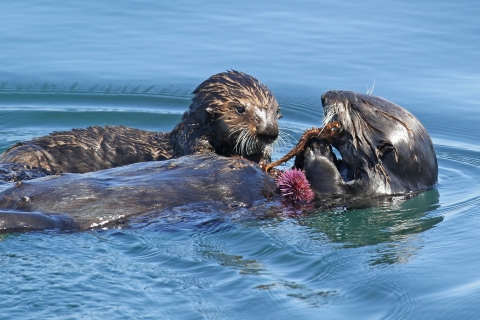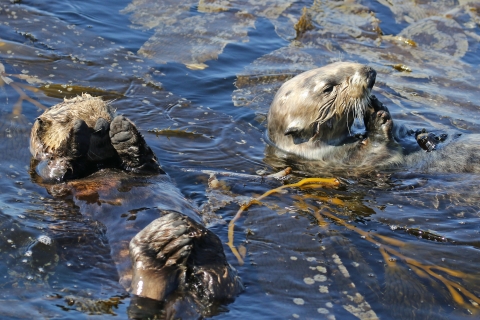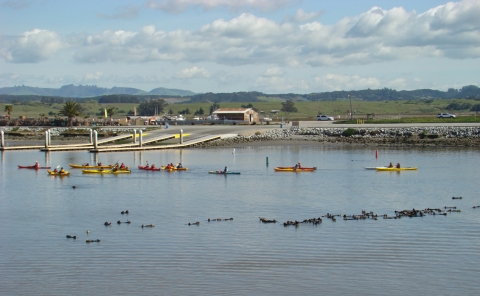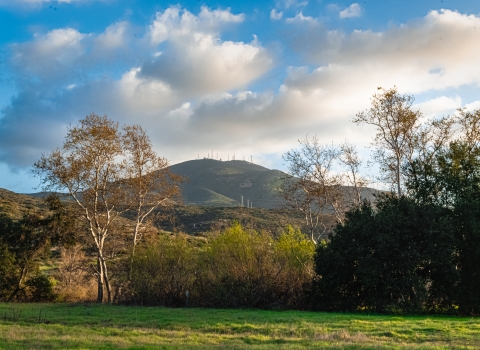By Oregon Coast Aquarium, Turtles Fly Too, Monterey Bay Aquarium and the U.S. Fish and Wildlife Service
A stranded southern sea otter pup found at Asilomar State Marine Reserve in Pacific Grove, California this May has found a new permanent home at Oregon Coast Aquarium. The young pup was cold and lethargic, and his mother could not be located.
“A sea otter pup’s mother is the sole caregiver for the first six months of life, which can take a toll on a single parent,” said Lilian Carswell, southern sea otter recovery and marine conservation coordinator for the U.S. Fish and Wildlife Service. “Feeding and caring for a pup can deplete the mother’s energy resources.”
While the cause of Southern Sea Otter 918’s stranding is unknown, at just three weeks old and weighing about 6.5 pounds, the pup would have been unable to survive on his own.
The young pup was taken to Monterey Bay Aquarium where he received treatment and ongoing care. While surrogate sea otter mothers have been used to rear and prepare stranded pups for eventual release to the wild, there were no surrogates available to care for the pup at the time. As such, he was deemed non-releasable by the Service.
Once it was determined that the Oregon Coast Aquarium would be 918’s new home, Turtles Fly Too volunteered to transport the precious cargo from California to Oregon. Turtles Fly Too coordinates the use of general aviation to transport endangered species and critical response teams and to educate the community on marine life conservation.
“We specialize in transporting endangered species, yet [this otter] challenged us with lower temperature needs, medical team support during the flight and securing a high-speed aircraft to reduce the risk for our special passenger,” said Leslie Weinstein, President of Turtles Fly Too.
“Safe transport of the pup from California to Oregon would not have been possible without the donation of time and talent from Turtles Fly Too,” Carswell said. “This transport is making room for the next stranded pup that comes into Monterey Bay Aquarium, potentially freeing personnel to care for a pup that has a chance to be released.”
Oregon Coast Aquarium’s Curator of Marine Mammals Brittany Blades, along with Willamette Veterinary Hospital’s Dr. Dan Lewer, assisted in the transport of 918 from California to Oregon. They closely monitored his health and took measures to make the flight as comfortable as possible for the pup.
“We are so excited to welcome Earle [SSO 918] to the Aquarium,” said Blades. 918 was named Earle after oceanographer and explorer Sylvia Earle. “Earle will act as an ambassador for his species, connecting guests with ocean life and inspiring conservation. That connection is crucial to the protection and preservation of sea otters and other endangered species.” Watch Earle live at the Oregon Coast Aquarium.
Southern sea otters are protected by the federal Endangered Species Act, Marine Mammal Protection Act and California law. Hunted to near extinction, they have since returned to West Coast waters; however, they continue to face serious threats, from bites by great white sharks to changing ocean conditions as a result of climate change climate change
Climate change includes both global warming driven by human-induced emissions of greenhouse gases and the resulting large-scale shifts in weather patterns. Though there have been previous periods of climatic change, since the mid-20th century humans have had an unprecedented impact on Earth's climate system and caused change on a global scale.
Learn more about climate change .
“Southern sea otters are essentially at carrying capacity based on available food supplies in the central portion of their mainland range, and they continue to face high levels of shark-bite mortality in the northern and southern peripheries,” Carswell said. “That’s hemming them in to a small area that’s just a fraction of their historical range.”
In California alone, the carrying capacity—the maximum number of sea otters the habitat is able to support—is about 17,000. Today the southern sea otter population hovers around 3,000, up from around 50 in the early 1900s. Scientists say expanding their range is a key component for their recovery, as well as for the restoration of coastal ecosystems.
Sea otters keep important elements of nearshore marine ecosystems, like kelp forests and seagrass beds, thriving. Kelp and seagrass provide habitat for thousands of other species. They also capture carbon dioxide from the atmosphere and store it where it can't contribute to climate change. Sea otters help maintain kelp by preying on sea urchins, which can clear-cut kelp forests when left unchecked. And they enhance the resilience of seagrass by consuming crabs, which prey on the surface grazers—like sea slugs—that clean fouling organisms off the seagrass blades.
Because they live and feed along shorelines, southern sea otters can also help humans detect pollutants and pathogens washed down from coastlands.
“SSO 918 will help make people aware of the challenges that face southern sea otters in the wild and the critical role they play in the marine environment along the West Coast,” Carswell said.






